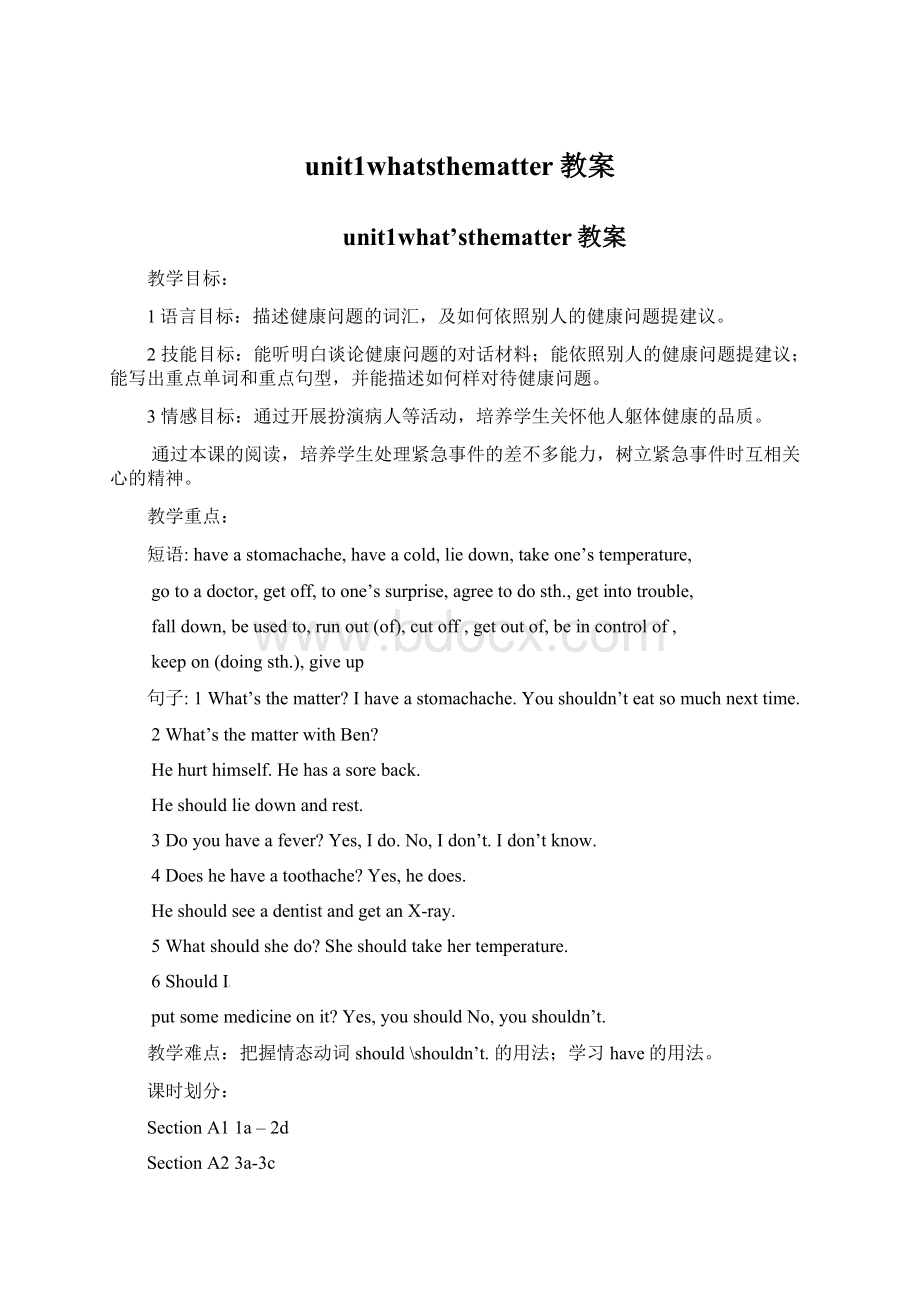 unit1whatsthematter教案Word文档格式.docx
unit1whatsthematter教案Word文档格式.docx
- 文档编号:19974802
- 上传时间:2023-01-13
- 格式:DOCX
- 页数:23
- 大小:34.88KB
unit1whatsthematter教案Word文档格式.docx
《unit1whatsthematter教案Word文档格式.docx》由会员分享,可在线阅读,更多相关《unit1whatsthematter教案Word文档格式.docx(23页珍藏版)》请在冰豆网上搜索。

6ShouldI
putsomemedicineonit?
Yes,youshouldNo,youshouldn’t.
教学难点:
把握情态动词should
\shouldn’t.的用法;
学习have的用法。
课时划分:
SectionA11a–2d
SectionA23a-3c
SectionA3GrammarFocus-4c
SectionB11a-2e
SectionB23a-Selfcheck
SectionA1(1a–2d)
Step1Warmingupandnewwords
1.Lookatapictureandlearnthepartsofthebody.
2.Newwordsandphrases.
Step2Presentation
1aLookatthepicture.Writethecorrectletter[a-m]foreachpartofthebody.
___arm___back___ear___eye___foot
___hand___head___leg___mouth
___neck___nose___stomach___tooth
Step3Listening
1bListenandlookatthepicture.Thennumberthenames1-5
Listentotheconversationsagainandfillintheblanks.
Conversation1
Nurse:
What’sthematter,Sarah?
Girl:
I___________.
Conversation2
What’sthematter,David?
Boy:
I_________________.
Conversation3
What’sthematter,Ben?
Conversation4
What’sthematter,Nancy?
Conversation5
Betty:
What’sthematter,Judy?
Ann:
She__________________.
Step4Speaking
1cLookatthepictures.Whatarethestudents’problems?
Makeconversations.
Examples
A:
What’sthematterwithJudy?
B:
Shetalkedtoomuchyesterdayanddidn’tdrinkenoughwater.
Shehasaverysorethroatnow.
What’sthematterwithSarah?
B:
Shedidn’ttakecareofherselfontheweekend.Shewasplayingwithherfriendsattheparkyesterday.Thenitgotwindy,butshedidn’tputonherjacket.Nowshehasacold.
Step5Guessinggames
Guesswhathashappenedtothestudentsbyusingtheimportantsentences.
Step6Listening
2aListenandnumberthepictures[1-5]intheorderyouhearthem.
2bListenagain.Matchtheproblemswiththeadvice.
Step7Speaking
2cMakeconversationsusingtheinformationin2aand2b
A:
What’sthematter?
Myheadfeelsveryhot.
Maybeyouhaveafever.
WhatshouldIdo?
Youshouldtakeyourtemperature.
Step8Role–play
Imagineyouaretheschooldoctor.Afewstudentshavehealthproblems.Role-playaconversationbetweenthedoctorandthestudents.
2dRole–playtheconversation
Step9Languagepointsandsummary
1.What’sthematter?
这是人们专门是大夫和护士询问病人病情时最常用的问句,意思是“如何了?
”其后通常与介词with连用。
类似的问句还有:
What’swrong?
如何啦?
What’swrongwithyou?
你如何了?
What’syourtrouble?
What’sthetroublewithyou?
What’sup?
2.haveacold伤风,感冒,是固定词组,表示躯体不适的常用词组还有:
haveabadcold重感冒
haveafever发烧
haveaheadache头痛
haveastomachache肚子痛,胃痛
haveatoothache牙痛
Summary:
1.牙疼haveatoothache
2.胃疼haveastomachache
3.背疼haveabackache
4.头疼haveaheadache
5.喉咙疼haveasorethroat
6.发烧haveafever
7.感冒haveacold
8.躺下同时休息liedownandrest
9.喝热蜂蜜茶drinkhotteawithhoney
10.喝大量水drinklotsofwater
11.看牙医seeadentist
12.量体温takeone’stemperature
13.看大夫gotoadoctor
Step10Exercises
依照上下文意思填空。
Mandy:
Lisa,areyouOK?
Lisa:
I_____aheadacheandIcan’tmovemyneck.What______Ido?
ShouldI
_____mytemperature?
Mandy:
No,itdoesn’tsoundlikeyouhaveafever.What_____youdoonthe
weekend?
Iplayedcomputer_____allweekend.
That’sprobablywhy.Youneedtotakebreaks_____fromthecomputer.
Yeah,IthinkIsatinthe_____wayfortoolongwithoutmoving.
Ithinkyoushould____downandrest.Ifyourheadandneckstillhurttomorrow,thengotoa_______.
OK.Thanks,Mandy.
翻译下列句子:
1.你如何了?
我头痛。
2.他如何了?
他发烧
3.李雷如何了?
他喉咙痛。
他应该多喝水。
4.假如你的头和颈项改日仍旧疼的话,请去看大夫。
Homework:
Makeupaconversationbetweenadoctorandapatient.
SectionA2(3a–3c)
Step1Presentation
Lookatthepicture.Discusswhathappenedandthenwhatweshoulddo.
Teacher:
Whathappenedinthepicture.
Students:
Whatshouldwedotohelpthem?
Didthebusdriverhelpthem?
Step2Reading
3aReadthepassageandanswerthefollowingquestions.
Doyouthinkitcomesfromanewspaperorabook?
Howdoyouknow?
Didthebusdriverhelpthemanandthewoman?
3bReadthepassageagainandcheckthethingsthathappenedinthestory.
1____WangPingwasthedriverofbusNo.26at9:
00a.m.yesterday.
2____BusNo.26hitanoldmanonZhonghuaRoad.
3____Theoldmanhadaheartproblemandneededtogotothehospital
rightaway.
4____Thepassagersonthebusdidnotwanttogotothehospital,soonly
WangPingwentwiththewomanandoldman.
5____Somepassagershelpedtogettheoldmanontothebus.
6____Theoldmangottothehospitalintime.
Step3Speaking
3cDiscussthequestionswithapartner.
Step4Languagespoints
1....whenthedriversawanoldmanlyingonthesideoftheroad.
......这时司机看到一位老人正躺在路边。
观看与摸索:
你能看出“看到某人正在做某事”的句型吗?
seesb.doingsth.看见某人正在做某事
e.g.WhenIpassthewindowIseehimdrawingapicture.
seesb.dosth.看见某人做过某事
e.g.Ioftenseehimdrawapicture.
活学活用:
1)我看见他时他正在河边玩。
Isawhim_______bytheriver.
2)我看见过他在河边玩。
Isawhim_____bytheriver.
3)我看着他过了桥。
Iseehim______acrossthebridge.
4)我看见她正在洗碗。
Iseeher_________thedishes.
2.Thebusdriver,24-year-oldWangPing,stoppedthebuswithoutthinkingtwice.
3.Heonlythoughtaboutsavingalife.
你能看出“withoutthinking”、“aboutsavingalife”的共同点吗?
共同点:
介词+doing;
介词+名词、宾格代词、doing
用适当的形式填空。
1)Iamfine.Whatabout____(she)?
2)Thanksfor______(tell)methestory?
3)Itisasunnyday.Howabout_____(go)fishing?
4)Itisgoodtorelaxby______(use)theInternetor_________(watch)gameshows.
4.Buttohissurprise,theyallagreedtogowithhim.
toone’ssurprise
使......惊奇的是,出乎......意料
e.g.Totheirsurprise,allthestudentspasstheexam.
Muchtoeveryone’ssurprise,theplansucceeded.
5....becausetheydon’twantanytrouble,...
当trouble意为“困难;
苦恼”时,是不可数名词。
如:
I’msorrytogiveyousomuchtrouble.
(1)beintrouble意为“有困难;
陷入逆境”。
如:
Healwaysasksmeforhelpwhenheisintrouble.
(2)getsb.intotrouble意为“使某人陷入逆境”。
Ifyoucome,youmaygetmeintotrouble.
(3)主语+have/hastrouble(in)doingsth.意为“某人在做某事方面有困难”。
Ihavesometrouble(in)readingtheletter.
当trouble意为“苦恼事;
烦心事”时,是可数名词。
Shewasonthephoneforanhourtellingmehertroubles.
【运用】依照汉语意思完成英语句子,每空词数不限。
(1)他认为每天吃饭是一件苦恼事。
Hethinksthateatingeverydayis_________.
(2)你明白你现在什么缘故处于逆境吗?
Doyouknowwhyyou_____________now?
(3)我妹妹在学习英语方面有困难。
Mysister_____________________English.
6.rightaway意为“赶忙;
赶忙”,和inaminute意思相近。
例如:
I’llbethererightaway/inaminute.
另外,rightnow和atonce也可表示“赶忙;
赶忙”的意思。
你必须赶忙动身。
Youmuststart_________________________________________.
重点短语
1)看到某人正在做某事seesb.doingsth.
2)让某人吃惊的是toone’ssurprise
3)下车getoffthebus
4)上车getonthebus
5)多亏,幸亏thanksto
6)考虑thinkabout
7)同意做某事agreetodosth
8)造成苦恼getintotrouble
Step5Exercises
用括号内的词的适当形式填空。
1.Thedriversawanoldman_____(lie)ontheroad.
2.Isatinthesamewaywithout________(move).
3.Heonlythoughtabout______(save)alifeanddidn’tthinkabout_______(him).
4.Theoldmanneeded_____(go)tothehospital.
5.Awomanwas________(shout)forhelp.
6.Heexpectedthem______(get)offthebus.
SectionA3(Grammarfocus–4c)
Step1Revision(Guessinggame)
Lookatthepictures,guesswhathashappenedandrevisetheimportantpointsthestudentshavelearned.
Step2Grammarfocus
What’sthematter?
Ihaveastomachache.
Youshouldn’teatsomuchnexttime.
What’sthematterwithBen?
Hehurthimself.Hehasasoreback.
Heshouldliedownandrest.
Doyouhaveafever?
Yes,Ido./No,Idon’t./Idon’tknow.
Doeshehaveatoothache?
Yes,hedoes.
HeshouldseeadentistandgetanX-ray.
Whatshouldshedo?
Sheshouldtakehertemperature.
ShouldIputsomemedicineonit?
Yes,youshould./No,youshouldn’t.
观看与摸索
读以下四个句子,总结出have的用法。
have\has
Ihaveabag.
Hehasnoodlesforbreakfast.
Ihaveabadcold.
Theyhavealookatthepicture.
用法展现
1.作“有”讲。
如:
Ihaveabag.我有一个包。
Hehasaredcup.他有一个红杯子。
2.作“吃、喝”讲。
havebreakfast(吃早饭)havetea(喝茶)haveabiscuit(吃块饼干)haveadrink(喝点水)
3.作“患病”讲。
haveacold,haveafever
4.固定短语
haveatry,havealook,haveaparty
活学活用
1.她有许多好朋友。
She____lotsofgoodfriends.
2.当我们感冒时,应该多喝水。
Whenwe_____badcolds,weshoulddrinkmorewater.
3.他早餐常吃鸡蛋。
He____eggsforbreakfast.
4.他昨天去参加聚会了。
He___________yesterday.
should
should属情态动词,后接动词原形,没有人称和数的变化。
用于提出建议劝辞别人。
should的否定形式为shouldnot,通常缩写为shouldn’t。
1.—Tom,Ihaveatoothache.汤姆,我牙痛。
—Youshouldseeadentist.你应当去看牙医。
2.—I’mnotfeelingwellthesedays.Ihavebadcough.
这些天我躯体不适,老是咳嗽。
—Youshouldn’tsmokesomuch,Ithink.
我认为你不该抽这么多烟。
3.—ShouldIputso
- 配套讲稿:
如PPT文件的首页显示word图标,表示该PPT已包含配套word讲稿。双击word图标可打开word文档。
- 特殊限制:
部分文档作品中含有的国旗、国徽等图片,仅作为作品整体效果示例展示,禁止商用。设计者仅对作品中独创性部分享有著作权。
- 关 键 词:
- unit1whatsthematter 教案
 冰豆网所有资源均是用户自行上传分享,仅供网友学习交流,未经上传用户书面授权,请勿作他用。
冰豆网所有资源均是用户自行上传分享,仅供网友学习交流,未经上传用户书面授权,请勿作他用。


 铝散热器项目年度预算报告.docx
铝散热器项目年度预算报告.docx
